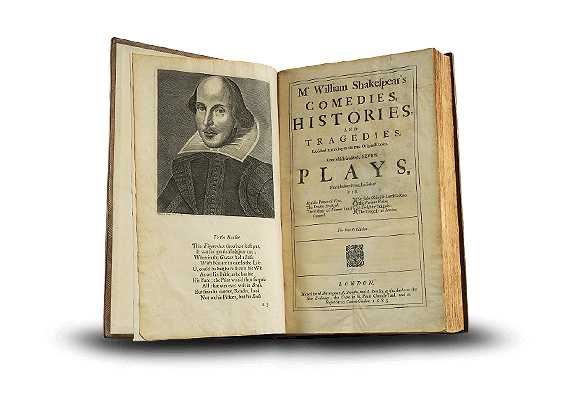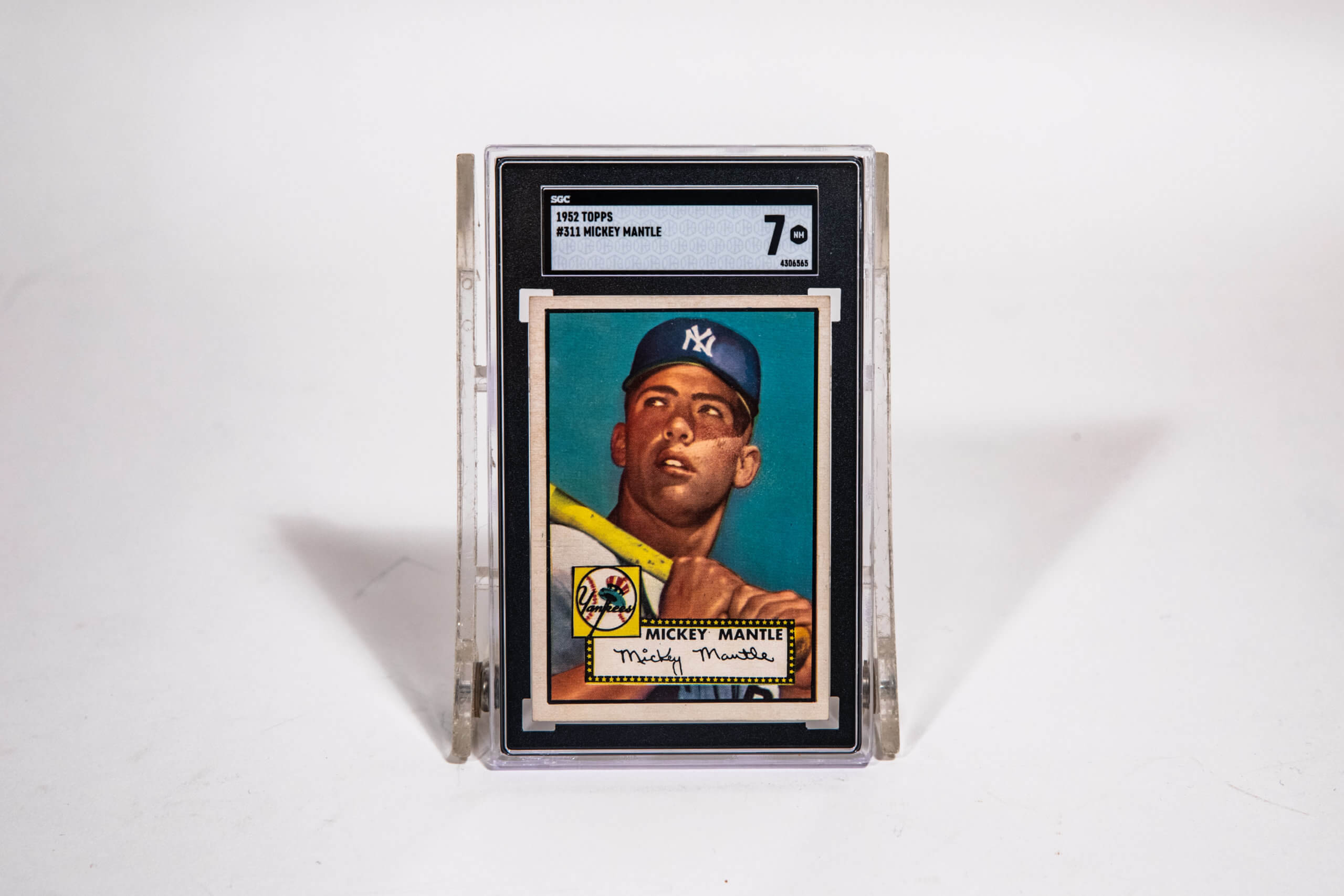Blog > Stories
Don’t You Forget About Me: Shakespeare’s Folio and His Friends

Blog > Stories
Don’t You Forget About Me: Shakespeare’s Folio and His Friends

Intro note: This write up is published in 2023, 400 years after the release of the First Folio. Globally, there are a lot of events celebrating this anniversary and you might be surprised what’s happening in your hometown libraries and museums. The New York Public Library is displaying six different copies of the First Folio in the Polonsky Exhibition through October 1st.
In our favorite stories, the hero often says some version of, “I can’t ask you to risk X on my account [again]” It’s at the end, before they step into the worst of whatever shit they’re in. Their friends, always, come along anyway. The Lord of the Rings. Harry Potter. The Fast and the Furious, where someone usually insists that you don’t even need to ask. Stranger Things. It! And, the collected plays of William Shakespeare?
400 years ago, two friends of the recently-deceased William Shakespeare did a revolutionary thing for the playwright, putting together the First Folio and publishing what is now considered one of the most important books in the history of English literature. He didn’t dare while he was alive, but John Heminge and Henry Condell, who had been named in Shakespeare’s will and allotted money for mourning rings, conspired against social norms, good fiscal planning, and plain common sense to elevate and immortalize their friend’s work.
The act itself was freaking bold – not unlike printing, embossing, and binding in tooled leather a collection of really good Instagram posts that got lots of likes*. Theater was the opiate of the masses for Elizabethan Europe and “folios,” as a format, were reserved for topics of social weight, long term importance, and intellectual prestige.
And the work was hard. One play was finalized so late that it’s in the collection, but not included in the table of contents, which had already been printed. It was undoubtedly expensive, and their opening plea to readers asks to “depends [sic] upon your capacities and not of your heads alone, but of your purses. … Whatever you do, buy.”
“depends [sic] upon your capacities and not of your heads alone, but of your purses. … Whatever you do, buy.”
– the burdened editors of Shakespeare’s First Folio
The Chosen Family Steps Up
Mr. William Shakespeare’s Comedies, Histories, and Tragedies (i.e. The First Folio) compiled by John Heminge and Henry Condell and published in 1623 was a revolution and, without it, University of Oxford Shakespeare scholar Emma Smith says “…we wouldn’t even be talking about Shakespeare.” [Smithsonian Magazine] They took on this expensive, frustrating, complex, bold (foolish?) project because they loved their friend’s work and we know so because they added their own sweet homages in the introduction.
“His mind and hand went together: And what he thought, he uttered with that easinesse, that wee have scarse received from him a blot in his papers. But it is not our province, who onely gather his works, and give them you, to praise him….” they write. “Reade him, therefore; and againe, and againe.” [spelling preserved from the original printing]
The First Folio collects 36 plays, 18 of which had not been previously published**. Let’s put a very fine point on that – without this work, we wouldn’t have Macbeth, The Tempest, As You Like It, or Julius Caesar today. No, “Something wicked this way comes.” Not a peep of, “All the world’s a stage / And all the men and women merely players.” And, depressingly, no 10 Things I Hate About You, which was based on The Taming of the Shrew, another of the unpublished works. Fun fact: The collection is also the first time that Shakespeare’s plays are sorted into Comedies, Histories, and Tragedies – a convention that stands today.
Each One is like Different Different
The 900-page book was also edited as it was printed, without replacing the errored pages. And so, like Honus Wagner cards, each of the 235 remaining copies are different. Some substantially. Many have reader doodles and annotations, some have entirely repeated sections filling in for missing parts, and one is pierced with a bullet hole (the round was stopped at Titus Andronicus and Shakespearian scholar Eric Rasmussen quipped, “… is clearly an impenetrable play.” [Smithsonian Magazine]). The book’s introduction also included lists of original actors in the company and what is considered the best portrait of the playwright, as it was made contemporaneously and selected by people who knew him personally.
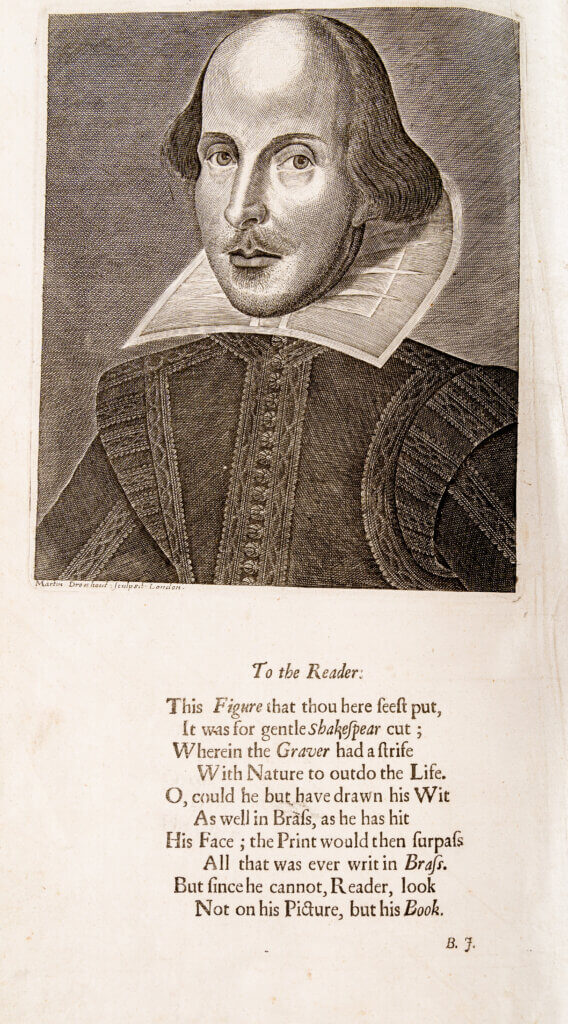
Folio finders (a real and obsessive thing) have documented their censuses of known authentic First Folios – Rasmussen’s The Shakespeare First Folios: A Descriptive Catalogue covers his work and Andrea Mays’ The Millionaire and the Bard: Henry Folger’s Obsessive Hunt for Shakespeare’s First Folio covers Folger’s global hunt. The Folios have often been stolen and tracking them down is not unlike a Dewey Decimal Indiana Jones. A copy was brought to scholars in 2002, saying that it came from one of Fidel Castro’s bodyguards, but had actually been taken from a university library (check out the Grateful Dead poster backstory for more references to library theft that is very bad but also fun to read about). Another was hanging out in a country manor’s library after Oxford’s Bodleian Library replaced their First Folio with the “updated and enhanced” (our words) Third Folio, treating it like a new release of a chemistry textbook. In Japan, a copy was hidden from view until 13 years after the owner’s death – terms laid out in their last will and testament.

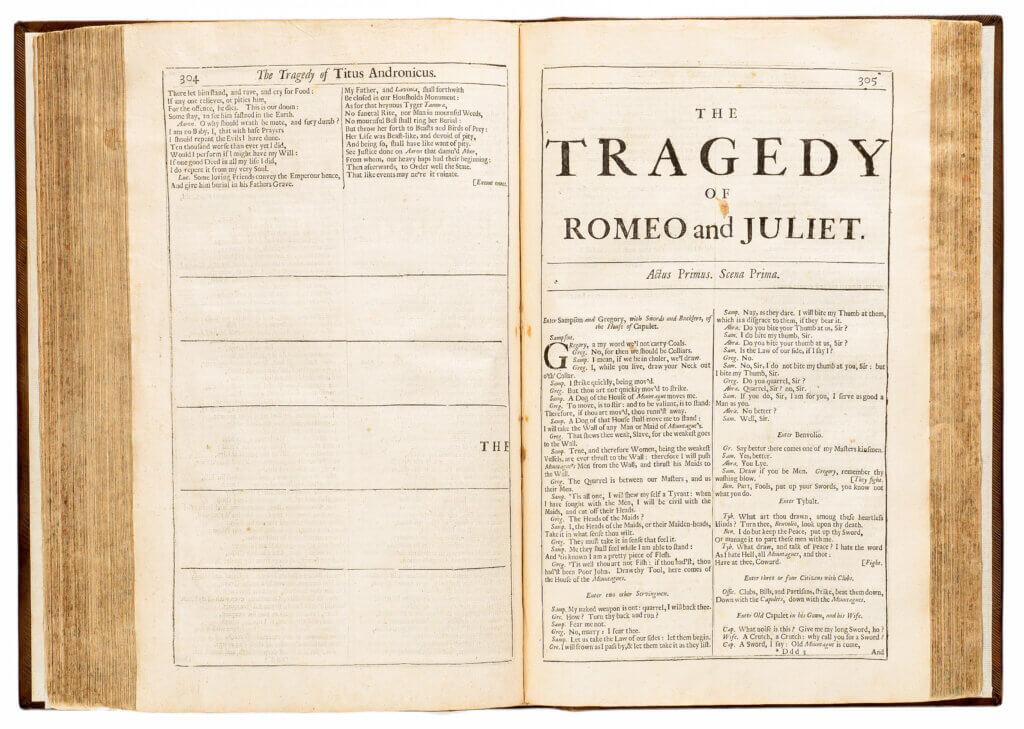
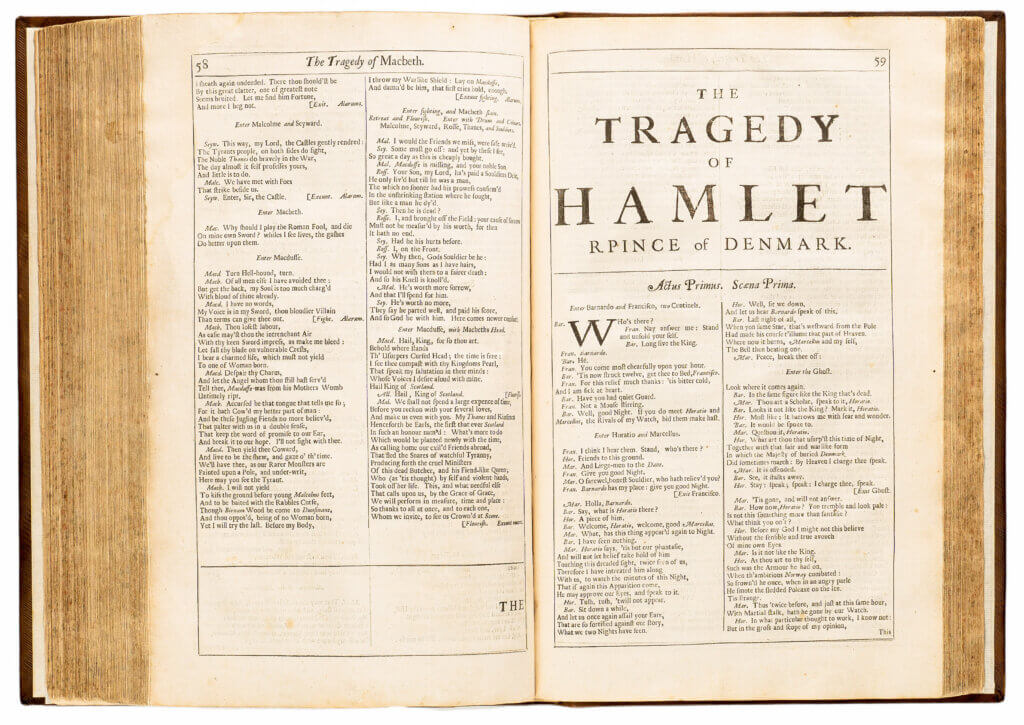

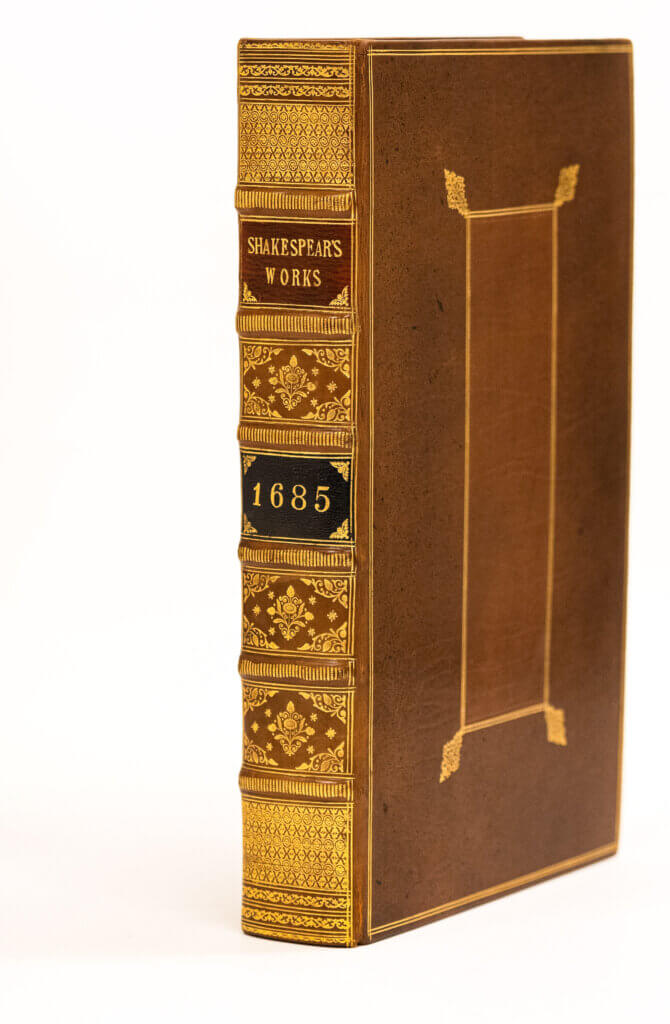
The Fourth (and Second and Third) Folios
Rally’s copy is from a small run called the Fourth Folio. Printed in 1685 and continuing the train of original publishing agreements, this edition stood as the document of record through the following century, but later scholarship refocused onto the First Folio as the closest to Shakespeare’s original language and canon. There are good reasons for both of these priorities! Each version of the folios tweaked the language to more closely match contemporary usage (common, but probably not ideal). There were also huge discrepancies between some of the plays’ quarto versions and inconsistencies between different people typesetting the manuscripts (here’s a side-eye to you, compositor E, who had “… significant difficulties in dealing with manuscript copy.” [Wikipedia excerpt, https://en.wikipedia.org/wiki/First_Folio]) that were reconciled throughout Folio editions. Common practice, and generally a good thing!
Most notably, the Third Folio publisher, Philip Chetwinde, added seven plays that he attributed to Shakespeare through a faulty, but not crazypants, methodology. He turned out right on Pericles, but not the rest. Both the Third and Fourth versions contain the same extra plays.
Each edition was considered, in its time, an improvement. The Fourth, and final, Folio is the largest and (in Sotheby’s words) “stateliest” as it’s printed on larger Royal Paper stock. Many of the First Folios are variable sizes as the books were trimmed throughout the years and the Third Folio has fewer known copies than the second or the fourth, possibly due to the Great Fire of London in 1666. Wild!
Thank You for Being a Friend
There are treasures in this world that were designed to be precious from the start. And there are amazingly valuable things that are worth so much because of a combination of scarcity and an unforecastable place in history. The Shakespeare Folios are a little bit of both. The work they document was intended to be smart, insightful, and moving; but also temporary, ephemeral, and sometimes casual. The “value” was in performing the plays, yeah? But the Folios organized by John Heminge and Henry Condell, friends of Shakespeare, took up a gauntlet to not just document their friends’ work, but to force the acceptance of that work as capital-a Art. Mr. William Shakespeare’s Comedies, Histories, and Tragedies is, at its core, a couple of guys unwilling to let their friend’s work fade into obscurity.
*From a social-status standpoint, not a level-of-effort standpoint, but content creation is also hard, y’all
**For more discussion on quatros, “bad quatros,” and folios; their authenticity and survival rates; and explanations of how these plays had been written down but would have been lost by now, you can start at https://en.wikipedia.org/wiki/Bad_quarto
[Images/text of the First Folio taken from] The Bodleian First Folio: digital facsimile of the First Folio of Shakespeare’s plays, Bodleian Arch. G c.7. URL: http://firstfolio.bodleian.ox.ac.uk/.
Rally Assets:
Shakespeare: Comedies, Histories, and Tragedies (Fourth Folio)
1966 Grateful Dead: Skeleton & Roses Poster
Rally-published articles:
- Rally. “Grateful Dead Skeleton Roses Poster.” Rally, n.d., https://rallyrd.com/grateful-dead-skeleton-roses-poster/.
- Rally. “The Holy Grail of Baseball Cards.” Rally, n.d., https://rallyrd.com/holy-grail-baseball-card/.
Sources:
Polonsky, Irene. “Shakespeare’s First Folio at 400: Discover the Library’s Six Copies.” NYPL Blogs, 19 Apr. 2023, https://www.nypl.org/blog/2023/04/19/shakespeares-first-folio-400-discover-librarys-six-copies-polonsky-exhibition.
Nash, Elizabeth. “Without the First Folio, William Shakespeare’s Plays Would Be Lost to History.” Smithsonian Magazine, 30 Mar. 2022, https://www.smithsonianmag.com/history/without-first-folio-william-shakespeare-plays-lost-history-180982021/.
Lander, Jesse M. “The First Folio of Shakespeare.” Shakespeare Online, n.d., http://www.shakespeare-online.com/biography/firstfolio.html.
“First Folio.” Wikipedia, 26 Apr. 2023, https://en.wikipedia.org/wiki/First_Folio.
“Folio vs. Quarto: What’s the Difference?” Folger Shakespeare Library, n.d., https://www.folger.edu/explore/folio-vs-quarto-whats-the-difference.
“Third Folio.” Times Pencil, n.d., https://timespencil.org/exhibits/show/shakespeares-folios/third-folio.
“Fourth Folio.” Times Pencil, n.d., https://timespencil.org/exhibits/show/shakespeares-folios/fourth-folio.
“Early texts of Shakespeare’s works.” Wikipedia, 17 Apr. 2023, https://en.wikipedia.org/wiki/Early_texts_of_Shakespeare%27s_works.
Sotheby’s. “English Literature, History, Science, Children’s Books and Illustrations Online.” Sotheby’s, 11-18 Jul. 2018, https://www.sothebys.com/en/buy/auction/2018/english-literature-history-science-childrens-books-and-illustrations-online/dae34edd-2412-41b1-8024-600de38c2043.
Additional Reading:
Smith, Zachary Lesser. Shakespeare’s First Folios: A Descriptive Catalogue. University of Oxford Press, 2016,
Smith, Emma. Shakespeare’s First Folio: Four Centuries of an Iconic Book. Oxford University Press, 2016.
Mays, Andrea. The Millionaire and the Bard: Henry Folger’s Obsessive Hunt for Shakespeare’s First Folio. Simon & Schuster, 2016.



